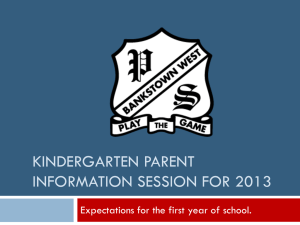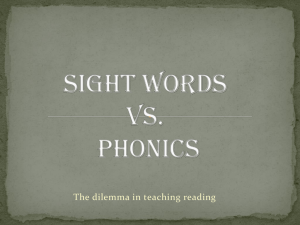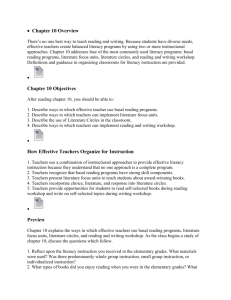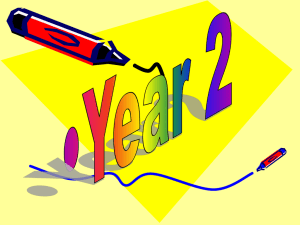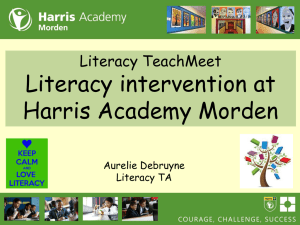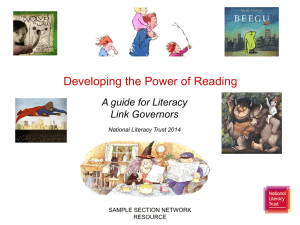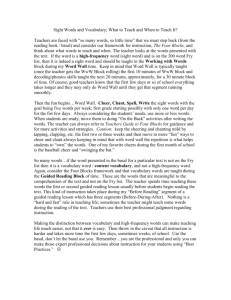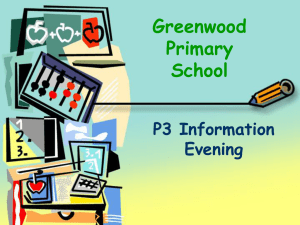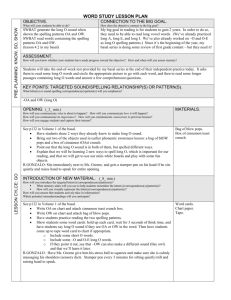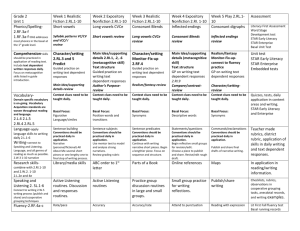CHAPTER TWO APPROACHES TO READING INSTRUCTION
advertisement
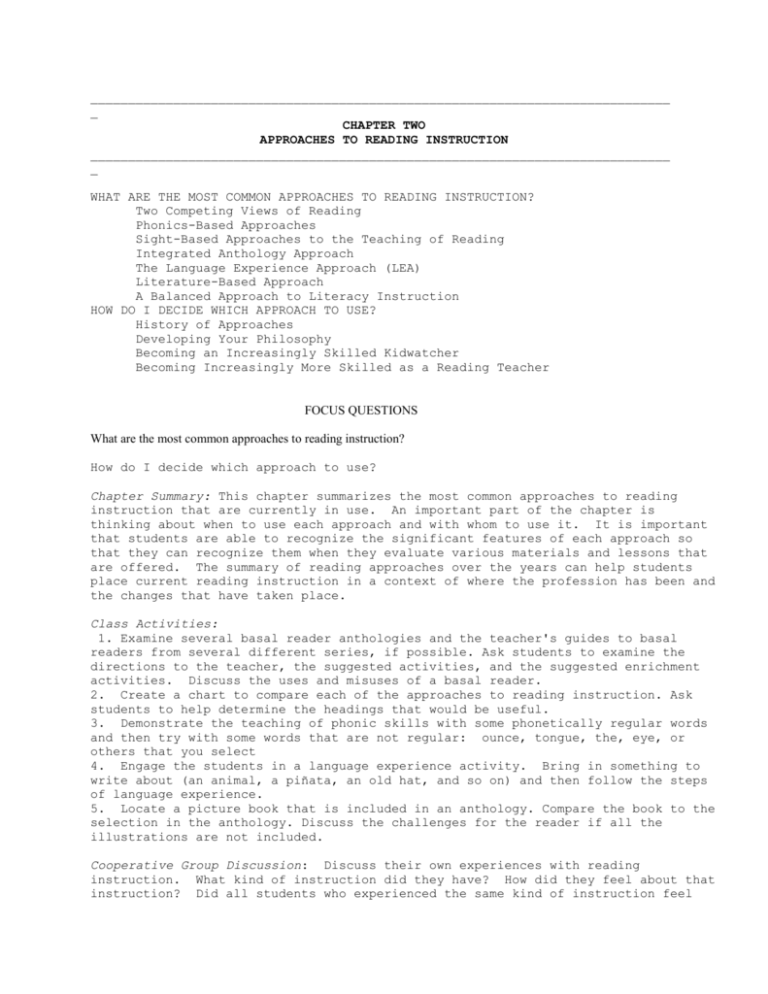
_____________________________________________________________________________ _ CHAPTER TWO APPROACHES TO READING INSTRUCTION _____________________________________________________________________________ _ WHAT ARE THE MOST COMMON APPROACHES TO READING INSTRUCTION? Two Competing Views of Reading Phonics-Based Approaches Sight-Based Approaches to the Teaching of Reading Integrated Anthology Approach The Language Experience Approach (LEA) Literature-Based Approach A Balanced Approach to Literacy Instruction HOW DO I DECIDE WHICH APPROACH TO USE? History of Approaches Developing Your Philosophy Becoming an Increasingly Skilled Kidwatcher Becoming Increasingly More Skilled as a Reading Teacher FOCUS QUESTIONS What are the most common approaches to reading instruction? How do I decide which approach to use? Chapter Summary: This chapter summarizes the most common approaches to reading instruction that are currently in use. An important part of the chapter is thinking about when to use each approach and with whom to use it. It is important that students are able to recognize the significant features of each approach so that they can recognize them when they evaluate various materials and lessons that are offered. The summary of reading approaches over the years can help students place current reading instruction in a context of where the profession has been and the changes that have taken place. Class Activities: 1. Examine several basal reader anthologies and the teacher's guides to basal readers from several different series, if possible. Ask students to examine the directions to the teacher, the suggested activities, and the suggested enrichment activities. Discuss the uses and misuses of a basal reader. 2. Create a chart to compare each of the approaches to reading instruction. Ask students to help determine the headings that would be useful. 3. Demonstrate the teaching of phonic skills with some phonetically regular words and then try with some words that are not regular: ounce, tongue, the, eye, or others that you select 4. Engage the students in a language experience activity. Bring in something to write about (an animal, a piñata, an old hat, and so on) and then follow the steps of language experience. 5. Locate a picture book that is included in an anthology. Compare the book to the selection in the anthology. Discuss the challenges for the reader if all the illustrations are not included. Cooperative Group Discussion: Discuss their own experiences with reading instruction. What kind of instruction did they have? How did they feel about that instruction? Did all students who experienced the same kind of instruction feel the same way about their experience? Another discussion topic would be the answers they provide to the questions on p. 60. These questions should help students think more deeply about their own philosophy. A discussion with a group can help students clarify their own thinking about these questions. If you are going to assign a philosophy statement as one of the assignments, you would want students to begin by having them answer these questions. Issues Discussions: Discuss the issues boxes in their small groups and then provide a summary of their opinions for the class. These might also be posted to the threaded discussion board on the website for the book. Summarizing: It will be important that students can identify the major approaches to reading instruction. On a transparency or sympodium screen list each approach and ask students to list the major ideas under each approach. Video Tape Suggestions: The Primary Literacy Video Collection Classroom Management (1) Managing the Day (2) Planning for Effective Teaching, Fountas and Pinnell, Heinemann. Key Information: Having a clear understanding of the major approaches to reading instruction is vital. Students can keep a copy of the list produced in the summarizing activity or make their own list to keep in their notes. Key terminology: The terms describing phonics, phonetics, and letter/sound relationships are often confused; these terms should be clarified. The terminology of whole language and literature-based instruction are also often used interchangeably, especially in the popular press; these should be clarified as well. Chapter 2 Multiple Choice Questions 1. What is the most important variable in the teaching of reading? A. The teacher B. The materials used C. The approach or method taken D. The age of the student 2. When confronted with competing approaches to reading instruction you will make your selection based upon: A. research about the approach. B. your personal philosophy of literacy instruction. C. your assessment of what your students need. D. All of the above 3. In A. B. C. D. the bottom up view of reading the instruction begins with: reading sentences. whole stories. the smallest pieces of language- the sounds (phonemes). blending sounds in words. 4. Heidi Mesmer (1991) suggested that decisions about reading materials in the classroom are: A. complex and are better made by taking into consideration which book will work for which readers at which developmental stages. B. easy under the guidance of a knowledgeable teacher. C. difficult and are mandated by the state legislature. D. perplexing and are best made by the school’s Curriculum Director. 5. What is the A. To teach B. To point language C. To teach D. To build goal of sight-based reading instruction? challenging words out the inconsistency in the sound/symbol patterns of our children that letters can represent sounds an increasingly large sight vocabulary 6. The instructional focus of basal readers has changed in recent years to include: A. phonics and sight word instruction. B. reading, writing, spelling, grammar and handwriting. C. memorization of vocabulary words. D. the reinforcement of words, skills and moral values. 7. Advocates of the Language Experience Approach believe everything children read in beginning reading instruction should be: A. decodable text. B. sight words and challenging words. C. as meaningful and relevant to the children as possible. D. None of the above 8. In a classroom in which interesting things are happening, finding something for children to write about is: A. not a problem. B. extremely difficult. C. challenging. D. time consuming. 9. The purpose of taking dictation in the Language Experience Approach is to: A. correct the child’s grammar. B. allow children to see their own ideas in print. C. write down what the child should say. D. record your thoughts about frogs. 10. In the Language Experience Approach read-aloud sessions with your students should include: A. reading the children’s work. B. reading narrative books on the topic. C. reading informational books on the topic. D. All of the above 11. A A. B. C. literature based reading program requires organizational skills and assessment skills. many books and time set aside for reading them. knowledge of children’s literature and the ability to differentiate instruction to meet the students’ needs. D. Both A and C 12. Individualized reading is defined as reading instruction that is organized so that all instruction is provided individually or in small groups and : A. each child is reading a book of their choice. B. every child is reading the same book. C. small groups of children are reading the same book. D. the teacher assigns a book to each child. 13. Whole language is a philosophy about teaching and learning that is: A. classroom friendly and uses books with decodable text. B. child-centered and embraces the use of good children’s literature. C. teacher based and encourages individualized reading. D. child-centered and utilizes integrated anthologies. 14. Reading instruction that includes word study, engaging with meaningful tests, instruction in reading skills and strategies and thoughtful communicative writing instruction would be the A. whole language approach. B. the basal reader approach. C. the balanced approach. D. language experience approach. 15. Advocates of a balanced approach to literacy instruction embrace integration of: A. the learners culture and values. B. all the language arts; reading, writing, speaking, listening, and viewing. C. subjects across the curriculum. D. Both B and C. 16. To balance reading instruction properly, a teacher must know about A. phonics, individualized reading, language experience, whole language and sight word strategies. B. the number of books per student in the library. C. the student's reading level. D. teacher directed instruction and learner directed discovery. 17. To make the most mindful professional decision about which literacy approach to use in your classroom you will need to consider A. the history of reading approaches. B. your own philosophy of literacy instruction. C. the nature and purpose of each approach. D. all of the above. 18. Yetta Goodman (1985) stated that kidwatching has caught on among those who believe that children learn language best in an environment A. with lots of books. B. full of friendly kids. C. rich with opportunities to explore interesting objects and ideas. D. with professional observation. 19. Contemporary wisdom within the teaching profession suggests that informed teachers focus on A. the parents of their students and the whole language approach to reading instruction. B. the needs of learners, use of an array of approaches and materials, and bringing balance to their reading instruction. C. their colleagues and their suggestions for approaches to use in the classroom. D. the children and the use of the language experience approach. 20. What, as the teacher, should you move toward if your student tends to fall behind his peers without teacher direction and has a loss of confidence and interest because he never seems to "get it" on his own? A. Teacher-directed instruction. B. Learner-directed discovery. C. Holistic focus. D. Standardized-norm referenced assessment Chapter 2 Essay Questions 1. Choose one of the four models of reading instruction as defined by Gracia and Pearson (1991) and explain the components to the model. 2. Explain the two competing views regarding phonics instruction, detailing the key points in each view. 3. Define the precepts of sound phonics instruction as viewed by Stahl, Duffy, Hester and Stahl (1998). 4. What are the three lessons adapted from the Bridge, Winograd, and Haley's1983 publication for using predictable books to build sight vocabulary? 5. What are the characteristics of literature based reading instruction? 6. A balanced approach to reading instruction for you as a teacher will include careful decision making to bring balance to what areas of instruction? 7. Describe at least three ways that you can become a more informed reading teacher. Chapter 2 Answer Key 1. A 2. D 3. C 4. A 5. D 6. B 7. C 8. A 9. B 10.20. 11. D 12. A 13. B 14. C 15. D 16. A 17. D 18. C 19. B A
